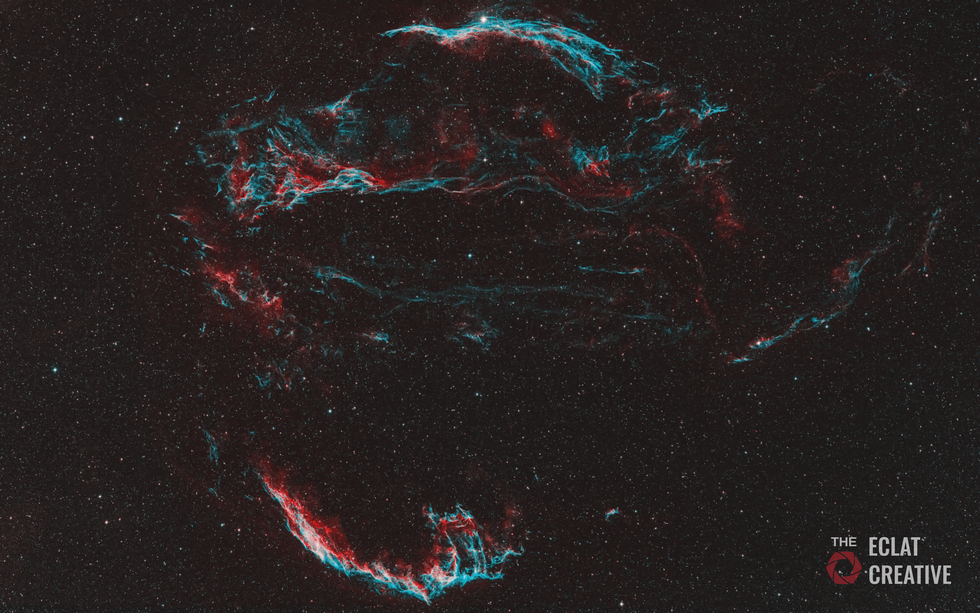Cygnus Loop
Cygnus Loop
SUPERNOVA REMNANT
.
Continuing the topic of the last image, the death of a star, this one is has a more interesting story. The Veil Nebula or Cygnus Loop is a Large Supernova Remnant (SNR) spanning over 130 light-years. It's very bright and very hot with most of the emissions in the ultraviolet frequency band! It is in-fact so large, that it would be 3 times the size of our moon if it were bright enough.
.
Now let's deconstruct what we are seeing. As a whole in this image, we can see that the shockwaves are travelling radially outwards hinting at a centre star that died in a massive stellar explosion that occurred between 5,000 to 8,000 years ago. If we were alive at the time, the supernova would have been so bright to be visible from the earth!
.
With such an incredible story, it sure is one of the most famous targets of the night skies and is subdivided into multiple parts that are bring studied individually. I've added a starless version as well to spot these areas better. Annotating below:
1) The bright start is 52Cyg, not interesting enough?
2) Western Veil or NGC 6960 is a small broom-like nebular region and is rightfully called Witch's Broom 🧹
3) Area below it to the left is called Pickering's Triangle 📐
4) Right below it is NGC 6979 and NGC 6974 which are two brighter knots of nebulosity in a cloud at the northern edge of the loop, to the east of the northern edge of Pickering's Triangle
5) The bottom beautiful red and blue part is called Eastern Veil and it is one of the brightest parts of the nebula
6) Right next to it to the right is a very faint Southeastern Knot
.
Acquisition:
IC Astronomy Observatory, Spain
2x300 second exposures H Alpha (Astrodon 3nm)
2x300 seconds for OIII (Astrodon 3nm)
Total Exposure: Only 20 Minutes 🤞
Gear: Takahashi FSQ-106EDX4 with FLI PL16083
Stacked on #deepskystacker and processed on PS @photoshop in HOO
.
Continuing the topic of the last image, the death of a star, this one is has a more interesting story. The Veil Nebula or Cygnus Loop is a Large Supernova Remnant (SNR) spanning over 130 light-years. It's very bright and very hot with most of the emissions in the ultraviolet frequency band! It is in-fact so large, that it would be 3 times the size of our moon if it were bright enough.
.
Now let's deconstruct what we are seeing. As a whole in this image, we can see that the shockwaves are travelling radially outwards hinting at a centre star that died in a massive stellar explosion that occurred between 5,000 to 8,000 years ago. If we were alive at the time, the supernova would have been so bright to be visible from the earth!
.
With such an incredible story, it sure is one of the most famous targets of the night skies and is subdivided into multiple parts that are bring studied individually. I've added a starless version as well to spot these areas better. Annotating below:
1) The bright start is 52Cyg, not interesting enough?
2) Western Veil or NGC 6960 is a small broom-like nebular region and is rightfully called Witch's Broom 🧹
3) Area below it to the left is called Pickering's Triangle 📐
4) Right below it is NGC 6979 and NGC 6974 which are two brighter knots of nebulosity in a cloud at the northern edge of the loop, to the east of the northern edge of Pickering's Triangle
5) The bottom beautiful red and blue part is called Eastern Veil and it is one of the brightest parts of the nebula
6) Right next to it to the right is a very faint Southeastern Knot
.
Acquisition:
IC Astronomy Observatory, Spain
2x300 second exposures H Alpha (Astrodon 3nm)
2x300 seconds for OIII (Astrodon 3nm)
Total Exposure: Only 20 Minutes 🤞
Gear: Takahashi FSQ-106EDX4 with FLI PL16083
Stacked on #deepskystacker and processed on PS @photoshop in HOO
SPECIFICATIONS
Telescope
Takahashi FSQ-106EDX4
Camera
FLI PL16083
Location
IC Astronomy Observatory, Spain
Date of observation
6th October
Filters
Astrodon Ha & OIII 3nm
Processing
HOO

